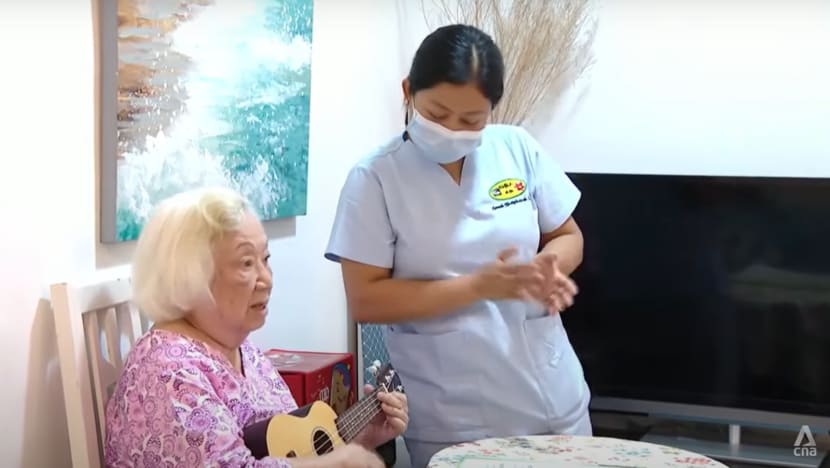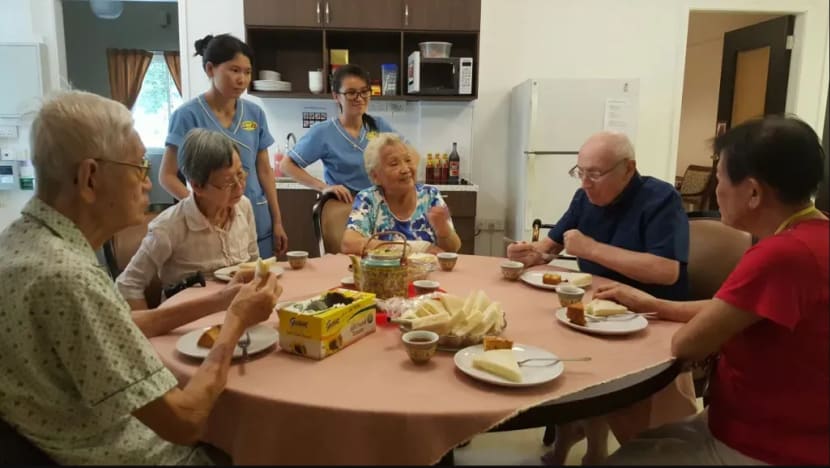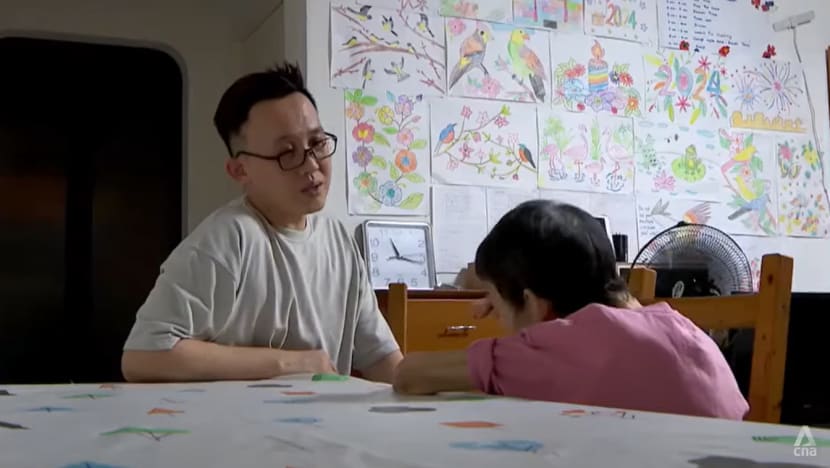Firms trialling alternative senior care model worry about hiring the right caregivers quickly
Companies offering such assisted living services have been given a bigger allowance to bring in foreign workers as caregivers, compared with ordinary nursing homes.

St Bernadette Lifestyle Village resident Lily Chew, 90, playing the ukelele.

This audio is generated by an AI tool.
SINGAPORE: Madam Lily Chew pays about S$5,700 (US$4,210) each month to enjoy the benefits of a new caregiving model, where live-in foreign workers help to take care of seniors like her in shared apartments.
The 91-year-old former teacher digs into her savings to stay at St Bernadette Lifestyle Village in Adam Road.
Unlike nursing homes, she can choose not to take part in rostered activities and even roam about freely in the neighbourhood. She also sings and reads in her free time.
Seniors there live in their own private ensuite rooms and have access to round-the-clock care.
“When it's time to go downstairs, the staff will take us and exercise daily … so I do what I can, and (they) also take me for a walk,” Mdm Chew told CNA.
The lifestyle village is run by one of five companies participating in a pilot government sandbox, which began in September last year. The sandbox aims to provide another care option for seniors to age gracefully.
The firms offering such assisted living services have been given a bigger allowance to bring in foreign workers as caregivers, compared with ordinary nursing homes.
This means they are now able to hire one caregiver for every three seniors they are looking after, with no cap. The ratio for nursing homes is one caregiver for a range of two to 30 seniors, depending on how much medical care a senior needs.
The firms hope to serve more seniors and are investing in training.
While this hiring ratio has helped their manpower situation, they also expressed concern over quickly finding workers with the right skills.
TRAINING SHOULD START EARLIER: COMPANY DIRECTOR
St Bernadette wants to care for 125 seniors by the end of 2024 – three times the current number. This means it will need about 40 workers.
Most of its hires hail from Myanmar or the Philippines. Professional courses can cost as much as S$2,000 and take up to a year to complete.
With no regulation on required skills at the moment, St Bernadette – which also runs a training centre – hopes to set industry standards.
St Bernadette Lifestyle Village director Belinda Wee said that caregivers are trained on topics like social care, de-escalating conflicts, and cultural norms in Singapore.
“These young caregivers come from a different culture,” she noted.
“Their seniors have a totally different behaviour – they may be more relaxed, more accepting of things, but our seniors come from a different culture.”

In terms of gaps that still need to be filled, Dr Wee, who is also co-founder of the Assisted Living Facilities Association, told CNA’s Singapore Tonight that the training should start in the caregivers’ home countries.
“I think by the time they come here, it's a little bit too late,” she said.
Moving forward, companies like St Bernadette hope that with more quality training, more Singaporeans will be drawn to the role. This could reduce reliance on foreign manpower which could be unsustainable.
Dr Wee said that being a caregiver in assisted living facilities can be a “very viable career option” for Singaporeans, though she noted that locals want due recognition and career progression.
“I think the salary is not really a problem because for the amount of levy we pay and having to house them and give them meals, it costs about S$3,000 per worker. I think for locals, this salary is reasonable,” Dr Wee added.
Some firms said that those who learn new skills can get better pay. Salaries are, on average, about S$1,800 a month currently for live-in foreign workers.
LOOKING FOR EXPERIENCED HIRES
Another firm under the sandbox, Red Crowns Senior Living, is also looking for experienced hires like former overseas nurses.
It has served more than 280 residents across more than 40 homes. Rather than having dedicated facilities, it rents Housing and Development Board flats as well as private condominium units to provide its services.
The company came under fire recently after the Ministry of Manpower found it had engaged in illegal employment practices.
It hired and deployed migrant domestic workers to provide caregiving services, allowing it to circumvent its foreign manpower quota and pay lower levy rates. The company and its directors were issued composition fines.
It has since corrected its operating model while continuing to care for existing clients. Migrant domestic workers who served as caregivers have been converted to work permit holders directly hired by Red Crowns.
Its staff get certification in eldercare or patient support from organisations like Dementia Singapore and N2 Hub Training Academy.
Caregivers also undergo monthly appraisals where they can receive S$100 or S$200 more. For those who acquire new skills, their remuneration is adjusted accordingly, said Mr Goh.
“The caregivers … will have to learn new things, new skills, like maybe wound management, diabetes care, things like that,” said Red Crowns founder Joshua Goh.
“Then, they will go through some of the partners – even our public hospitals – to train the caregivers on how to take care of the seniors.”

Such help could prove useful for those like Mr Alvin Gan’s mother, who has schizophrenia and lives with three others in a flat.
Mr Gan said that he used to be her primary caregiver, making sure she took her medications and had proper meals. When he got married and had children of his own, he took her to a day care facility for several years.
“But she didn't manage to actually make some friends, a long-term friendship,” Mr Gan recounted.
“There was no one taking care of her. When I went to work, the house was empty, only her staying all by herself, and she got very depressed.”
While considering going to a traditional nursing home, he learned about the Red Crowns model.
Staying in a flat with others has allowed her to interact with different people around her age. Mr Gan also said he can visit her anytime.
“Even before she was diagnosed with schizophrenia, there were not a lot of options left for me to look into. Mostly, I had to hire domestic maids to help her to take care, which I think is not the best solution because (the maid was) only able to take care of her in terms of meals and all,” Mr Gan said.
“In the past, she stayed all by herself ever since my dad passed on, so for many years, she was all alone. Emotionally, alone, mentally, she was alone as well.”
Now, Mr Gan said she has become the “youngest sister” in her flat and gets support from the other seniors.
“She opened up quite a lot. She's more open and more cheerful than before,” he added.



















